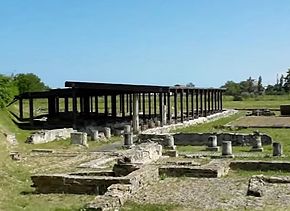Potentia (ancient city)

Archaeological area of Potentia
|
|
| Location | Porto Recanati, Province of Macerata, Marche, Italy |
|---|---|
| Type | Settlement |
| History | |
| Founded | 2nd century BC |
| Abandoned | 5th century |
| Periods | Roman Republic - Byzantine Empire |
| Cultures | Ancient Rome |
Coordinates: 43°24′51″N 13°40′16″E / 43.41410°N 13.67120°E
The now abandoned Roman town Potentia was located along the central Adriatic Italian coast, near the modern town of Porto Recanati, in the province of Macerata. Its original position was just north of the main Roman bed of the River Potenza (the ancient Flosis), which at present flows more than 1 km to the north.
In 268 BC the central Adriatic homeland of the local Picene peoples was military dominated and incorporated by the Romans. Later, under emperor Augustus, it was organized as Regio V Picenum. The installation of a series of mostly maritime Latin and Roman colonies during the second part of the 3rd and the 2nd centuries BC was a major impulse for the Romanization of a region that knew no real urbanized society before. In 184 BC with the foundation of Potentia, a coastal colony for Roman citizens (mentioned by Livy), the lower Potenza valley, and with it the whole area of northern Picenum, entered its first phase of real urbanization. By 174 BC the colony probably received a circuit wall with three arched gates, a street network with sewers, an aqueduct, a temple to Jupiter, and a portico with shops enclosing the forum. The flourishing of the town from the Augustan Age onwards far into the late 2nd century AD, is attested by epigraphic evidence. From the 3rd century AD onwards, the lack of significant numbers of inscriptions could point to a decline in the city’s prosperity. Although the city became an Episcopal seat around AD 400 and is still mentioned in sources at the beginning of the 7th century AD, Potentia clearly did not survive into the Middle Ages.
Nereo Alfieri, an Italian specialist in ancient topography, located the archaeological site of Potentia in 1940. The first architectural remains were investigated in the 1960s-70s under the direction of Liliana Mercando. Between 1986 and 2006 systematic excavation campaigns under the direction of Edvige Percossi of the Soprintendenza per i Beni Archeologici delle Marche, have been organized. These excavations revealed a late Republican temple (2nd century BC) surrounded by a portico and other buildings of Republican and Imperial Age. The Potenza Valley Survey Project (Ghent University), under the direction of prof. Frank Vermeulen, made it possible to understand the wider picture of the city’s plan and development. Due to intensive aerial coverage, geomorphological approaches, artefact surveys and studies, geophysical prospections, and the excavation of the western city gate there is now a more defined chronological interpretation of the site as well as a comprehensive cartographic mapping of its main features.
...
Wikipedia
